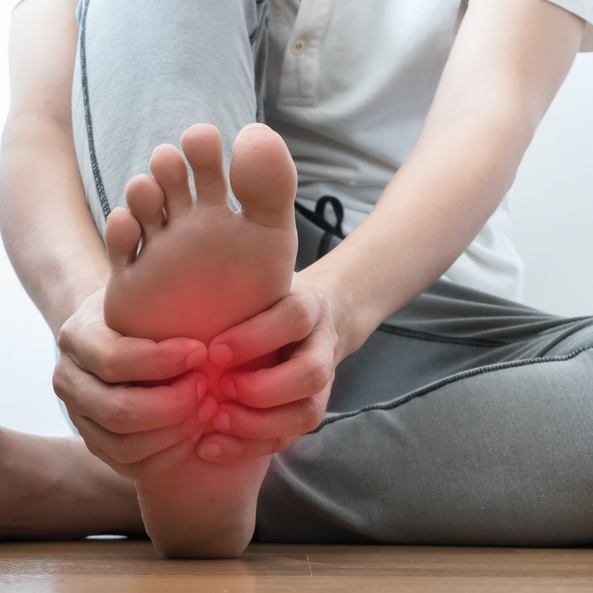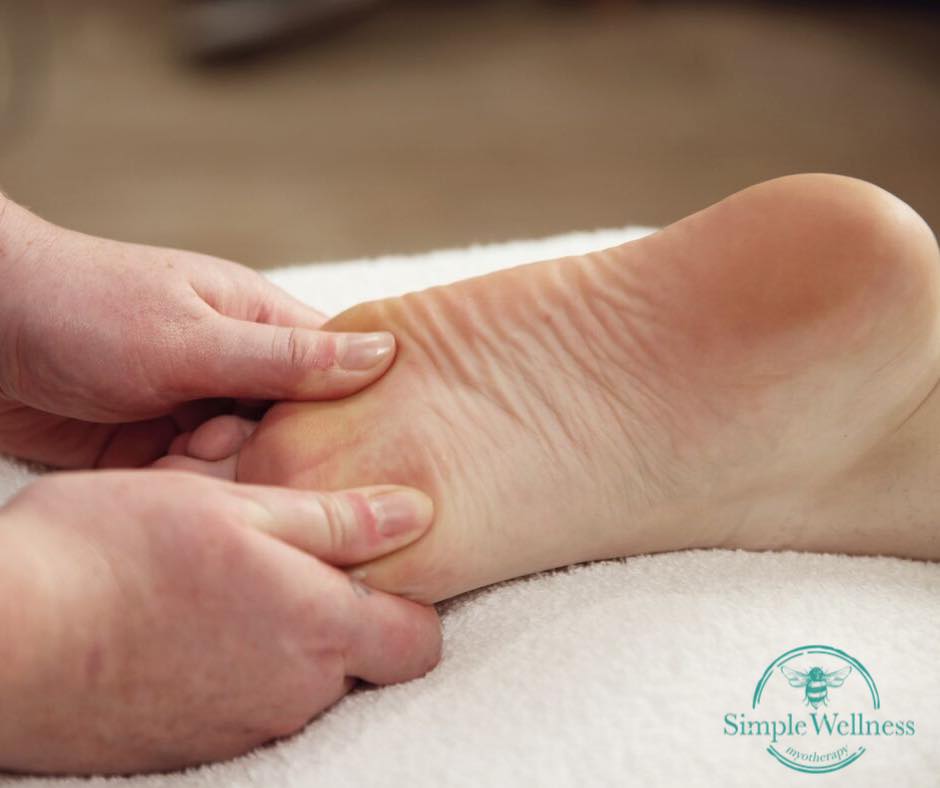|
By Ethan Farr, Sports Myotherapist & Exercise Scientist Plantar Fasciitis is a condition that has piqued my interest as I have also suffered from it and since I have had it I have grown a passion in treating it and fighting it off for good. But what is Plantar Fasciitis? Plantar Fasciitis is a musculoskeletal disorder characterised by heel pain that is exacerbated by weight-bearing activity and after extended periods of rest or sedentary behaviour - but what does this mean in english? Fundamentally Plantar Fasciitis is a long term (comes up repeatedly over a few months) pain at the bottom of the foot this can be heel or arch of the foot. It is worse after sitting or lying down, and it is most commonly felt first thing in the morning when you get up from bed but can be brought on after long periods of walking or standing.
Studies have shown that Plantar Fasciitis affects 10% of adults in their lifetime and is most common in individuals between the ages of 40 and 60 years old, but can affect a younger population of habitual runners or those that are just highly active. Where does it come from/ how do you get it? Plantar Fasciitis is multifactorial but has commonly been linked with; High impact exercise; Obesity; prolonged standing/sitting; flat feet; occupational use of equipment like heavy safety boots; and is highly prevalent in runners. Common practice for the treatment of Plantar Fasciitis includes stretching and exercises for the muscles around the ankle and sole of the foot, as well as using orthotics for the shoes you wear, and potentially using a glucocorticoid injection (Ouch). Did you know that there is another treatment option focusing on pain management making it much easier to do everything you need to do day to day without that constant ache in the feet nagging at you - but what is this miracle cure? Say hello to myofascial dry needling or MDN for short, MDN is a technique used by myotherapists and other healthcare professionals to treat myofascial pain and muscle tightness. It involves inserting acupuncture needles into trigger points (or “knots”) in a muscle to stimulate a healing response and release tension. Not to be confused with acupuncture, which is based on traditional Chinese medicine and focuses on balancing energy flow, MDN targets muscular issues directly, aiming to alleviate pain, improve range of motion, and promote healing. Many studies have supported the notion that MDN can be used in the treatment of Plantar Fasciitis and some studies have found that the use of MDN on the gastrocnemius and soleus (muscles in the calves) had a statistically significant (≥95% of participants experienced improvement) reduction in plantar fascial pain moderate (2 weeks post treatment) to long term (4 weeks post treatment) for most subjects. What does this mean for you? With reduced pain you are able to do the exercise needed to help strengthen and support your ankle and heel meaning if you take an active role post treatment your Plantar Fasciitis may not come back. For others who may not be capable to be more active in their recovery the ability to be pain free for up to 4 weeks is enough and they can seek regular maintenance treatments monthly or bimonthly to control pain. Ready to take the first step towards relief from Plantar Fasciitis? Book your session at Simple Wellness Myotherapy today and experience the transformative benefits of myofascial dry needling. Take charge of your recovery and bid farewell to foot pain for good! Foot and heel pain can really impact your day. It can be a hard area to avoid aggravating through use and movement, for obvious reasons! A very common cause of heel pain is a condition called Plantar Fasciitis. This is an inflammatory condition of the thick connective tissues of the heel and sole of the foot.
The sensation is usually described as a sharp, stabbing feeling directly under the heel. Its generally most painful first thing in the morning, or after resting for some time. Depending on the severity, this can last anywhere from a few moments, to being felt constantly throughout the day. It can be caused by an acute injury or strain to the plantar fascia, and can also develop over time. People who are on their feet for long hours can develop this foot pain, especially if they don't have good supportive footwear. Our bodies are pretty good at finding work arounds to keep us moving, so if you're experiencing plantar fasciitis, you may notice some compensation patterns like limping, reduced ankle mobility, taking smaller steps, or toe walking to avoid pressure to your heel. Short term, these compensation patterns are fine, but if the heel pain becomes chronic then these altered movement patterns can lead to other pains further up the body. What can be done about Plantar Fasciitis?
Do you need help with heel pain? Book in with our team so we can help you with a treatment plan. Does this sound familiar? Terrible pain in your first few steps in the morning. Pain on standing up if you’ve been sitting for a little while. Putting weight on that foot can be agony. You feel it strongest in the heel or arch of your foot. Once you get moving it seems to calm down. If you're saying yes to these symptoms, you could be dealing with a condition called Plantar Fasciitis. Its quite common, and one of the most frequent foot pains that our myotherapists help people with. Plantar Fasciitis is a very painful condition that affects your heel and the sole of your foot. Often the mornings are the worst pain, people often explain they feel like they have to hobble about for the first few minutes of their day.
Usually it affects one foot or the other - some very unfortunate people can get both feet affected at the same time. Symptoms include heel pain; arch pain; altered walking patterns; cramps or spasms in the sole of the foot. Usually the pain reduces after getting moving, but those first few steps can be uncomfortable through to excruciatingly painful. What kinds of treatments work best for Plantar Fasciitis? The techniques I've found that work the best for people with Plantar Fasciitis are:
The hands on treatment sessions are only part of the recovery plan though. Like with most pains or injuries, looking at the way you move and stretch outside of your time in the clinic is important to helping you feel better, quicker. Our therapists will show you some simple but effective movements that help you to stretch your foot and leg to reduce the pain. We can also offer you some temporary pain relief suggestions like ice bottle rolling and using spiky physio balls. Ready to look at a plan for kicking Plantar Fasciitis? Book a 60 Minute Initial Consultation with us. We'll assess your movement and muscle balance, give you a feel-good hands on treatment, and walk you step by step through your treatment plan. You might be familiar with that sharp, shooting pain sensation in your lower back, hip and leg. It can also be felt as numbness, pins and needles, tingling or burning type of sensations. Whatever way the pain or symptoms present, it runs along the Sciatic nerve - which is why this is referred to as Sciatica.
But did you know theres more than one potential cause behind this pain? Often this pain can be linked to muscle tension in the glutes and hips. The Sciatic nerve runs underneath the muscles of your glutes, and when it gets compressed there it can be a real pain in the bum - literally! Because this nerve runs all the way down to your feet, the jolts of nerve pain can sometimes be felt anywhere from just localised in your buttocks and hip, to the back of your thigh, behind the knee, straight down your lower leg and even into the base of your foot. The Sciatic nerve can be impacted at the root of the nerve near the spine, however this doesn't always mean there will be pain. Often this is called a Bulging Disc or Herniated Disc, but you might be surprised to learn that even though "Bulging Disc" sounds pretty awful, studies have shown that more than 50% of people over 40 with no pain symptoms at all can have a disc bulge show on scans. Irritation or compression of the Sciatic nerve can be common after serious trauma to your leg or lower back. Things like car accidents, falls, and horse riding accidents are all common high impact incidents that can aggravate the nerve. If you've had an injury like this, its wise to seek treatment for it. Do you have Sciatic nerve pain or nerve symptoms of numbness, tingling and pins and needles? Book an appointment with us to have an assessment and treatment. If we can resolve the issue, we'll create you a treatment plan that includes manual therapies and a take home exercise program. More serious causes do exist, so if treatment of the muscles and joints is not relieving your pain, we'll refer you to see your GP to rule out any serious structural or pathological conditions. |
Meet Our Team
We have a team of great practitioners available 7 days a week at our Rowville clinic. Archives
July 2024
Categories
All
|
Got a question about Myotherapy?
Contact Mel by phone, email or Facebook
|
Simple Wellness Myotherapy & Remedial Massage Clinic
Shop 12B 150 Kelletts Rd Rowville VIC 3178 |
Phone us on
03 8204 0970 |




 RSS Feed
RSS Feed